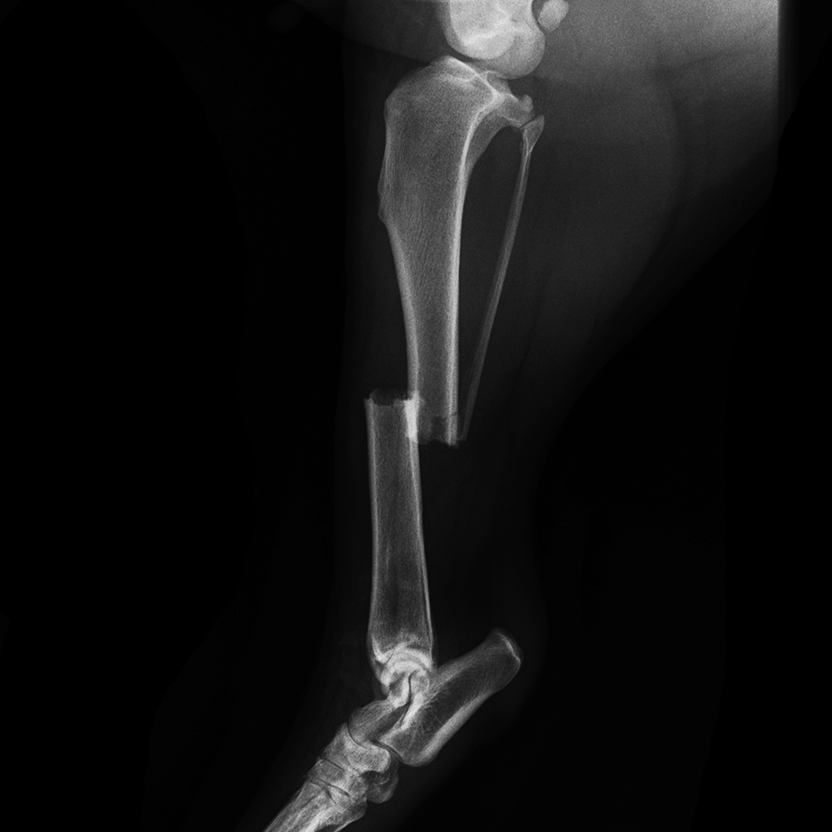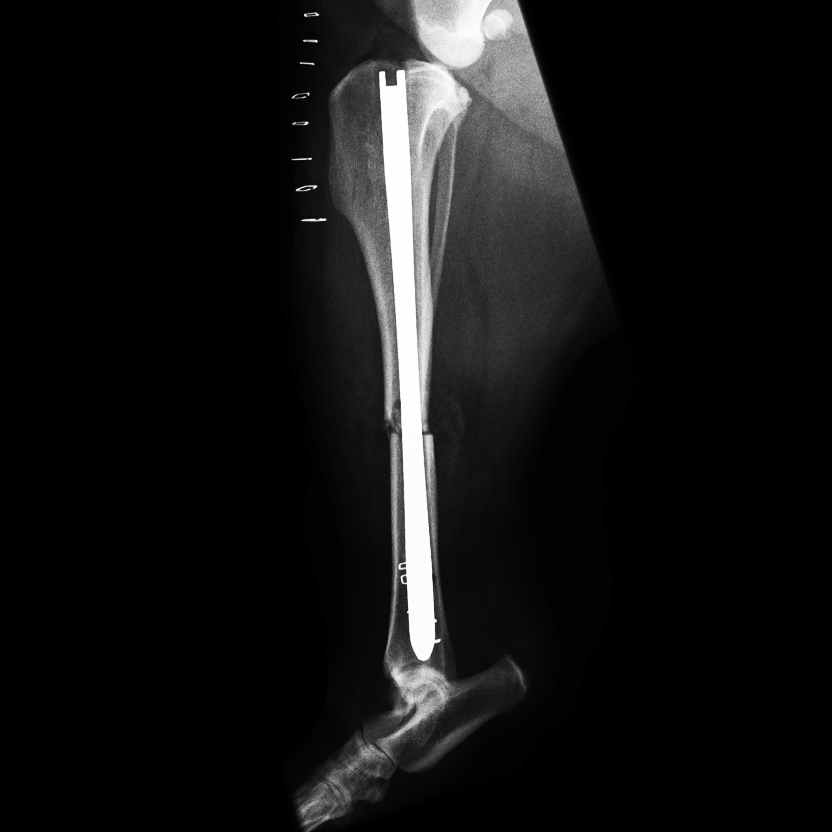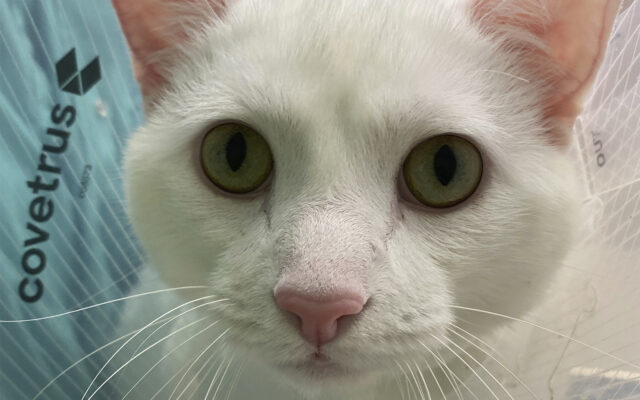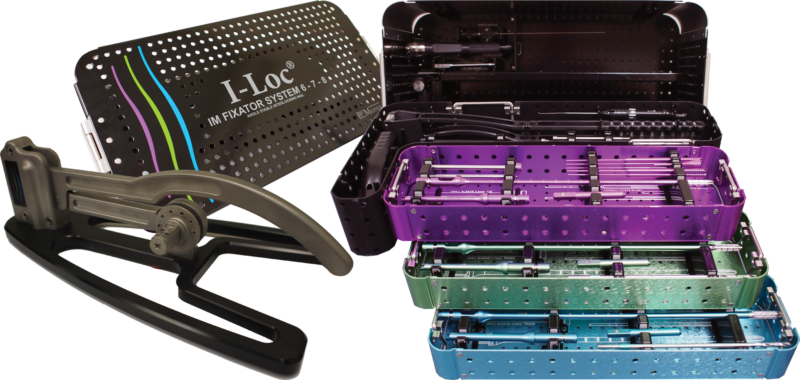INNOVATION • EDUCATION • SUPPORT
The Interlocking Nail
Primarily, interlocking nails are metallic implants used for the repair of traumatic long bone fractures. They consist of a large diameter rod, inserted into a bone medullary cavity and secured to it with locking bolts going from one cortex to another and capturing the nail inside the medullary cavity.
Thanks to its unique locking technology, the I-Loc can be used in a variety of fracture configurations including metaphyseal and periarticular fractures. The implant is designed to prevent post-operative instability through an innovative mechanical interlock between the nail and the bolts, which allows for immediate weight bearing activity.
Interlocking nails may also be used to stabilize corrective osteotomy such as those performed in cases of medial patellar luxation secondary to severe femoral varus deformity.
LONG BONE FRACTURE
Interlocking nails are not new to fracture repair. They actually have been the standard of care in human traumatology for several decades as they combine biological and mechanical advantages over plate systems. One of the biological advantages is the noninterference of the soft tissue envelope surrounding the fracture site. Thanks to their intramedullary insertion, they do not disrupt the periosteal blood supply, which is essential to bone healing following fracture.
On a mechanical standpoint, previous generations of interlocking nails present slack, and acute instability due to mismatch between holes in the interlocking nail and the locking bolts, responsible for delay in bone healing. The advent of the nail to hold mechanical lock eliminated this design flaw thus advancing nailing technology in a similar way that locking plates revolutionized bone plating.
In general, younger patients with single fractures treated minimally invasively tend to heal faster than older ones or than patients with more severe injuries. The anticipated healing time ranges from 3-4 weeks to 10-12 weeks in general. This compares to much longer healing times observed with previous nail designs and is thought to be related to the unique I-Loc locking design.
SURGICAL OVERVIEW
The first surgical step is the insertion fo the nail into the medullary cavity. The nail insertion must be normograde to enable proper placement of the aiming guide or jig used for bolt insertion. The medullary cavity is prepared to accommodate the adequate nail (diameter and length) using a series of dedicated awls. The fracture is reduced and the preparation is carried into the distal fragment prior to inserting the final implant. The nail is introduced using a handle secured to an extension affixed temporarily to the nail. The handle is ergonomic to allow easy insertion and also serves as a base for the aiming jig used to accurately guide the drilling of the holes for the locking bolts.
Once the bolt holes have been drilled, the bolts are secured to the interlocking nail thanks to the threaded Morse taper locking system. Since they do not require contouring and since implant insertion and fixation can be performed through remote incisions, interlocking nails are ideal for minimally invasive application. Using an interlocking nail following the principals of minimally invasive osteosynthesis is called MINO (as opposed to MIPO when using a bone plate) and is considered the standard of care in people.
The I-Loc IM Fixator surgical procedure requires special training to be performed reliably. Workshops are held regularly to provide surgeons with the resources to ensure full recovery.


RECOVERY
Most patients start bearing weight within 24 -48 hours following fracture repair. Some polytrauma patients may take longer to ambulate but most will have expedited recovery. The optimal stability afforded by the interlocking nail construct and the absence of interference with the tissues surrounding the fracture site are likely responsible for fast recovery, particularly when the surgery was conducted following minimally invasive surgical principals.

The BioMedtrix I-Loc Interlocking Nail System (Intramedullary Fixator) features an angle-stable locking mechanism for osteosynthesis of epiphyseal, metaphyseal and diaphyseal long bone fractures.

Elimination of slack, controlled compliance, with no reaming necessary:
- Promotes revascularization of the medullary cavity
- Enhances bone healing
Bullet nose geometry:
- Eases insertion without violating distal joint
- Impacts cancellous bone, improves anchorage
Bolts are accurately custom cut at surgery using a shearing tool for individual fit.
If an intramedullary implant can be used, it is very likely that an interlocking nail could be used too, provided that the medullary is a large enough diameter.
WORKSHOPS
BioMedtrix conducts product workshops throughout the United States and Europe. Each workshop details the application and surgical technique for a specific product such as the Universal Hip (BFX® and CFX® systems), Small Breeds Hip, TATE Elbow®, or I-Loc® Nail. Workshops consist of classroom instruction supported by lab experience, offering participants the opportunity to use the surgical instrumentation in order to familiarize themselves with the procedure.
FREQUENTLY ASKED QUESTIONS
Primarily, interlocking nails are metallic implants used for the repair of traumatic long bone fractures. They consist of a large diameter rod, inserted into a bone medullary cavity and secured to it with locking bolts going from one cortex to another and capturing the nail inside the medullary cavity. Thanks to its unique locking technology, the I-Loc can be used in a variety of fracture configurations including metaphyseal and periarticular fractures. The implant is designed to prevent post-operative instability through an innovative mechanical interlock between the nail and the bolts, which allows for immediate weight bearing activity. Interlocking nails may also be used to stabilize corrective osteotomy such as those performed in cases of medial patellar luxation secondary to severe femoral varus deformity.
Interlocking nails are not new to fracture repair. They actually have been the standard of care in human traumatology for several decades as they combine biological and mechanical advantages over plate systems. One of the biological advantages is the noninterferrence of the soft tissue envelope surround the fracture site. Thanks to their intramedullary insertion, they do not disrupt the periosteal blood supply, which is essential to bone healing following fracture. On a mechanical standpoint, previous generations of interlocking nails present slack, and acute instability due to mismatch between holes in the interlocking nail and the locking bolts, responsible for delay in bone healing. The advent of the nail to hold mechanical lock eliminated this design flaw thus advancing nailing technology in a similar way that locking plates revolutionized bone plating.
Alternative methods to interlocking nails include bone plates and screws, plate-rod combination, external skeletal fixation including tie-in configurations and pin/cerclage constructs. Interestingly, if an intramedullary implant can be used, it is very likely that an interlocking nail could be used too, provided that the medullary is a large enough diameter. Note that the I-Loc family is expanding towards smaller diameter implants with soon available a 4mm implant suitable for fracture repairs in cats and small dogs.
Bone plates and interlocking nail systems are not mutually exclusive. On a mechanical standpoint, the position of an interlocking nail within the medullary cavity enhance its ability to resist bending forces in all direction as opposed to bone plates which have strong anisotropic behaviors (their mechanical property highly depends on the direction of the applied force). This property is particularly suitable in cases where there is no load between implant and bone. In such instances, the implant affords all the forces occurring through the fracture site. Conversely, in cases where interfragmentary compression is desirable (such as intra-articular fractures) a bone plate might be better indicated, as it would allow for the placement of a lag screw. An additional major advantage of interlocking nails compared to bone plates is the absence of contouring need. Thanks to an intramedullary position and its unique hourglass shape, the I-Loc conforms perfectly to the cavity without any need for contouring.
The first surgical step is the insertion fo the nail into the medullary cavity. The nail insertion must be normograde to enable proper placement of the aiming guide or jig used for bolt insertion. The medullary cavity is prepared to accommodate the adequate nail (diameter and length) using a series of dedicated awls. The fracture is reduced and the preparation is carried into the distal fragment prior to inserting the final implant. The nail is introduced using a handle secured to an extension affixed temporarily to the nail. The handle is ergonomic to allow easy insertion and also serves as a base for the aiming jig used to accurately guide the drilling of the holes for the locking bolts. Once the bolt holes have been drilled, the bolts are secured to the interlocking nail thanks to the threaded Morse taper locking system. Since they do not require contouring and since implant insertion and fixation can be performed through remote incisions, interlocking nails are ideal for minimally invasive application. Using an interlocking nail following the principals of minimally invasive osteosynthesis is called MINO (as opposed to MIPO when using a bone plate) and is considered the standard of care in people.
Most patients start bearing weight within 24 -48 hours following fracture repair. Some polytrauma patients may take longer to ambulate but most will have expedited recovery. The optimal stability afforded by the interlocking nail construct and the absence of interference with the tissues surrounding the fracture site are likely responsible for fast recovery, particularly when the surgery was conducted following minimally invasive surgical principals.
As with any surgical procedure, there is a recovery period that requires restriction of activity and physical rehabilitation to optimize outcome and minimize the risk of postoperative complications. The length of recovery depends on numerous factors including the type of fracture, the presence of concurrent injuries, the type of surgical procedure (minimally invasive vs open approach) and the patient age. In general, younger patients with single fractures treated minimally invasively tend to heal faster than older ones or than patients with more severe injuries. The anticipated healing time ranges from 3-4 weeks to 10-12 weeks in general. This compares to much longer healing times observed with previous nail designs and is thought to be related to the unique I-Loc locking design.
In the majority of patients treated with interlocking nails (or with any implants aside from external skeletal fixator), the implants are meant to stay in place throughout the patient’s life. In rare occasions, the implant can cause discomfort or can become a source for infection, in which case implant removal becomes indicated. Implant removal is a much simpler procedure than the initial surgical intervention. During removal, the bolts are first removed through small individual incisions, then the nail is extracted using the same coupling system used for its insertion.
As with all surgical procedures, patient-owners should consult with their veterinary orthopedic surgeon prior to surgery concerning any potential risks associated with surgery.
.





